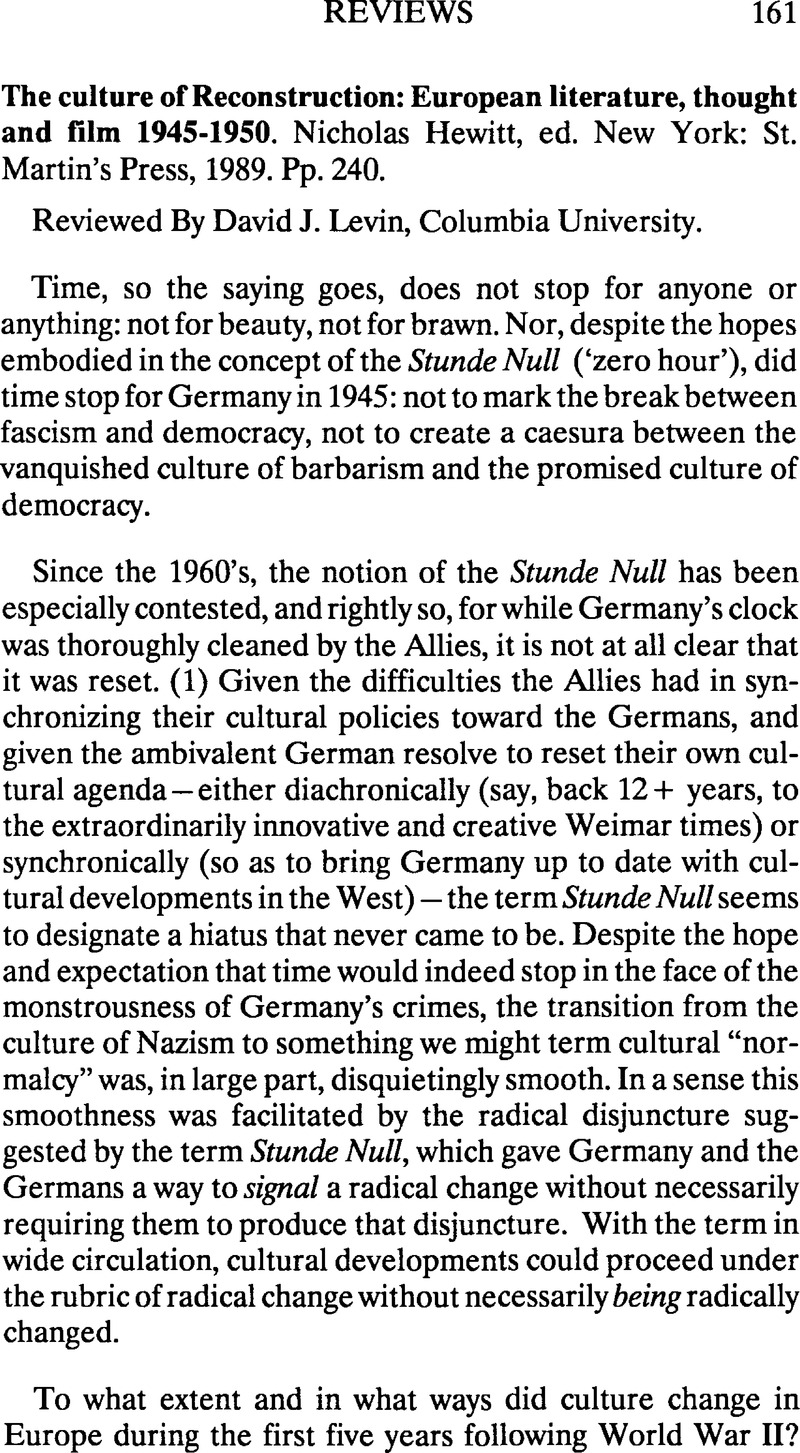No CrossRef data available.
Article contents
The culture of Reconstruction: European literature, thought and film 1945–1950. Nicholas Hewitt, ed. New York: St. Martin's Press, 1989. Pp. 240.
Published online by Cambridge University Press: 05 December 2008
Abstract

- Type
- Reviews
- Information
- Copyright
- Copyright © Society for Germanic Linguistics 1994
References
ENDNOTES
(1) There are a number of distinguished critics who would disagree. In After the fires, for example, Peter Demetz observes that “it has been argued by younger critics close to the student movement that in May 1945, when Germany surrendered to the allies, not much changed in writing. Those who were there definitely have other views” (21). In seeking to define the new writing after Auschwitz, Demetz dismisses purely generic concerns in favor of the presence of compassion; he cites Ilse Aichinger and Elisabeth Langgässer as exemplary novelists in this regard. See After the fires: Recent writing in the Germanies, Austria, and Switzerland (New York, 1986)Google Scholar. In The uncompleted past, Judith Ryan stakes out a middle position on the question of the Stunde Null, which she terms “a complicating factor in the development of postwar German literature”: “Although the notion of the zero hour was overstated”, writes Ryan, “it is certain that [postwar] writers were at a loss for appropriate literary models and grasped eagerly at whatever modern literature began to filter into Germany.” See The uncompleted past: Postwar German novels and the Third Reich (Detroit, 1983, p. 23).Google Scholar
(2) Bullivant mentions two seminal studies that have argued in a similar vein: Widmer's, Urs1945 oder die “Neue Sprache” (Düsseldorf, 1966)Google Scholar and Vormweg's, Heinrich “Deutsche Literatur 1945–1960: Keine Stunde Null”, originally published in 1971, reprinted in Durzak, M., ed., Deutsche Gegenwarts-literatur (Stuttgart, 1981).Google Scholar
(3) Thus, in an essay on “Neorealism in Italian cinema, 1945–54”, Christopher Wagstaff sidesteps the issue with an unremarkable platitude: “I do not intend to delve into the controversy over continuity, but for the purpose of illustrating the historiographical issues I must point out that much hinges on how widely or how loosely you define Neorealist cinema”(72). In “Writing and the real world: Narrative in the period of Reconstruction”, Michael Caesar argues that a “significant break” separated pre- and post-war Italian narrative, but attributes that break to something he terms “the cultural formation of the writers” as opposed to “the immediate impact of the events through which they lived and about which they wrote” (49–50). But what is the difference? Surely “cultural formation” is not ahistorical, and even to the extent that it is supposed to be ahistorical, as it was in Mussolini's Italy, it is, in that very determination, the product of ideological suppositions that are historically bound.
(4) Two of the titles that come to mind are Adorno's, Theodor “Cultural criticism and society” in Prisms, trs. Samuel, and Weber, Shierry (London, 1967)Google Scholar and Adorno, and Horkheimer's, MaxThe dialectic of Enlightenment, tr. John, Cumming (New York, 1972).Google Scholar




